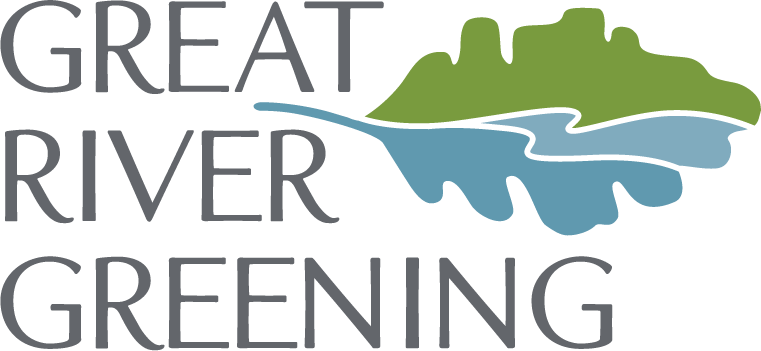Expanding Sustainable Agriculture Practices to Improve Water Quality
Great River Greening's restoration work in Southern Minnesota focuses on sustainable agriculture. Through partnerships, educational events, and relationship building, we confront rural water quality issues that affect the Minnesota and Mississippi Rivers.
When we test water quality, we look at its nutrient load, often affected by agricultural runoff. High concentrations of nitrogen and phosphorus are all too often found in drinking water, streams, and rivers.
The effects of poor water quality ripple through our land as well as our water. Invasive species thrive and wreak havoc on our forests, prairies, and cropping systems. We also see more soil erosion in ravines, streams, and parks.
In our outreach to farmers in Southern Minnesota, we promote practical, accessible tools and approaches, like woodchip bioreactors, cover crops, perennial crops, wetland restorations, and nutrient management.
Let’s Talk Kernza®
For example, we work with farmers who are early adopters in growing a new crop called Kernza®. This is the first perennial grain crop in the world, meaning the farmers don’t have to replant it every year.
The grain is like wheat and can be used in baked goods, cereal, and beer (see link below to buy grain or flour). Because it is a perennial crop, its roots stay in the ground for multiple years and retain more water and nutrients, thus improving water quality and reducing water volume downstream.
Challenges and Opportunities
Understandably, farmers can’t bear all the risk tied to these innovative practices when doing so could come at the cost of their livelihood. They respond better when they have economic support.
Farmers can pursue select activities that receive government reimbursements, like wetland restorations, but Great River Greening and its partners pay particular attention to activities that improve the farm’s bottom line independently.
Along with crops like Kernza® that are beneficial to the environment and anticipate a promising market, we promote crop rotations that include cover crops like winter camelina.
Beneficial Cover Crops
Cover crops are crops that a farmer plants in the fall and grows during the “off-season” of main crops like corn and soybeans. However, most cover crops don’t have a market. They just cover the ground to improve soil health, weed suppression, and water quality.
New cover crops like winter camelina can be harvested in the spring and sold for profit. That means the farmer can grow and harvest two crops in a single year. Now the cover crop reaps the same benefits while also increasing revenue.
Teaching and Learning
In eastern Nicollet County, we connect with farmers who are the first to grow Kernza® and winter camelina in that county. Great River Greening’s field days, dinners, and discussions give farmers the chance to ask questions, figure out where to sell the grain, learn about adjustments they would need to make to equipment, all while strengthening the community.
We also host hands-on, educational volunteer events for our silvopasture projects.
Hold on: What’s Silvopasture?
Silvopasture, in its simplest definition, is the grazing of livestock in wooded areas. We promote silvopasture as a restoration and forest management practice. Farmers remove buckthorn and other nuisance or invasive plants from forested areas, then use cattle, goats, sheep, and other livestock to graze the newly restored areas. Grazing prevents those unwanted plants from returning.
Silvopasture works particularly well in oak savannas where there are only 1-2 trees per acre and more sunlight hitting the ground. These conditions lead to denser ground cover, more food for livestock, and better flowering species for butterflies and bees.
Removing buckthorn and then grazing in these forested or oak savanna areas improves habitat and adds more productive acres to a farm’s operation – as in more acres that can be grazed to feed their livestock.
Great River Greening guides those initial restoration practices and promotes the farmers who do those environmentally beneficial activities; our partners work with us to teach farmers about proper fencing construction and livestock management.
To learn more about these various practices and activities, get involved, or order your own Kernza® flour, check out these links:
Silvopasture Volunteer Event in Howard Lake, October 14th: Register now
Seven Mile Creek Partnership website describing our work in Nicollet County
Perennial Pantry Kernza® Flour: Support the growing market of the new perennial promise
Blog and photos by Great River Greening’s Brad Gordon, Ph.D





